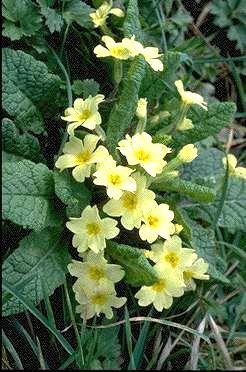The Two Seed Types of Flowering Plants
Monocotyledons

Monocotyledons make a seed with a seed coat. Inside the seed there is plant embryo with a primitive root and a supply of food for the new plant. The food supply is called the endosperm, and it is all in one piece. When the little plant comes out, the root goes down and a single spire goes up. The young plant uses the food resources of the endosperm to provide energy for growth.
The endosperm part (the inside of the corn kernel in our example) is the single seed leaf: the monocotyledon The parent plant has stored food in this kernel so that the young plant will have energy resources that it can use to start building itself up as the seed germinates.
Monocotyledons have other distinctive characteristics.
- The veins in their leaves are parallel to each other. Look at the picture of the trillium. The big veins in the leaves are all going in the same direction.
- Look at the purple crocuses at the top of the page. They also show parallel veins in their petals and long, thin leaves.
- Crocuses are also monocotyledons.
- The parts of the flowers of monocotyledons are arranged in threes or multiples of threes. Note that the trillium has three petals, and the crocus flowers have six petals. The stamens also follow this pattern.
- Examples of monocotyledons are the grasses, such as rice, corn, wheat, and sugar cane. The lily family is also a family of monocotyledons. Lilies have six petals on their flowers.
Dicotyledons
Dicotyledon seeds also contain an embryonic plant.

The seed is protected by a seed coat. There are two seed leaves inside the dicotyledon seed. (You can see the germination process on the Seed Germination page.) The seed leaves nourish the plant after it germinates.
Germinating dicotyledon plants all look very similar to this picture when they first begin to grow. The two seed leaves open and the shoot of the plant's characteristic leaves grows up between them.
Dicotyledon leaves are net-veined.
The flowers of dicotyledons have petals and other flower parts arranged in fours and fives, or in multiples of four and five. Roses have five petals. Cherry blossoms have five petals. Our fruit trees and deciduous trees are dicotyledons, as are many shrubs and flowers.
There are other differences between these two families of angiosperms, but the differences shown here should be enough to help you to identify the groups that plants belong in.
Remember that coniferous trees are gymnosperms. Coniferous trees do not belong to the angiosperm family. They come from a much more ancient lineage. They invented the seed a long time ago.
Document Actions

 Like us on Facebook
Like us on Facebook